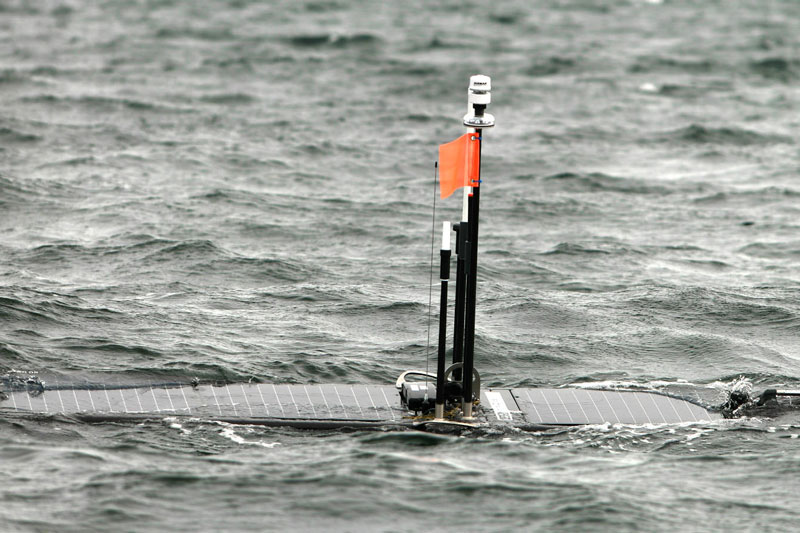Airplane tracking systems like FlightRadar24 rely on people running radios that receive the ADS-B signal and forward the data on to them. That doesn’t work so well in the middle of the ocean, though: in spots like the mid-Atlantic, there are no islands to speak of.
So, the service is now experimenting with a new approach: putting an ADS-B radio onto an autonomous boat. The boat is a Wave Glider from Liquid Robotics, an autonomous boat that harvests the power of the waves to run propulsion, guidance, and its payload. In this case, that payload includes an ADS-B receiver and a satellite transmitter that uploads the plane data to the service, where it is added to their mix of data sources. The boat is planned to spend the next six to eight weeks cruising about 200 miles off the coast of Norway, listening to the broadcasts of planes flying overhead and relaying them back to HQ. They will then be plotted on the live map in blue.
If you’re interested in building your own plane-trackers, we’ve got you covered, at least on land.
















This is a clever project. RADAR only goes about 200 miles off shore, and ADS-B VHF maybe goes line of sight. Aircraft at 30K FT and up will be able to transmit to this at least 100 miles away. That should extend ATC awareness at least 100 miles, maybe to 400 miles off shore.
North Atlantic Tracks is getting better, but mostly done with pilot reports and timing.
https://en.wikipedia.org/wiki/North_Atlantic_Tracks
FYI: With atmospheric ducting ADSB can travel 422 nmi (780 km ; 486 miles )
e.g. https://twitter.com/sdrsharp/status/733997894290804736
But you are at the whims of the weather for such good RF propagation.
At ground level with nothing blocking line of signt to the horizon, at Sea for example, and allowing for the curvature of earth the usual range would typically be:
250 nautical miles ( 450 km ; 288 miles)
This is really for FlightRadar24, not ATC. Most of the traffic over the NA reports their position to ATC via ADS-C (contract) that uses a satellite connection when out of range of land based radar and VHF receivers. Come November, when all the NAT tracks go to 30 nm spacing (instead of the previous 60 nm), you won’t be allowed to use the tracks without satellite ADS-C.
Even though ground based radar will only see a couple hundred miles offshore, ATC has awareness all the way across the pond.
Why can’t they use sea buoys? Here is an extensive list of them. However, Norway only has a few so I can see why they would want this. USA could use the plethora of buoys or add more.
http://www.ndbc.noaa.gov/
That’s a good point. Sea buoys seems like the a much better long-term solution. These would be good if you need to increase coverage in an area on short notice, but surely having a stationary tethered object would be easier to maintain than a unit that has to keep exerting itself in order to stay in place.
That’s a good point. Sea buoys seems like the a much better long-term solution. These would be good if you need to increase coverage in an area on short notice, but surely having a stationary tethered object would be easier to maintain than a unit that has to keep exerting itself in order to stay in place.
ATC doesn’t need the buoys because the ADS data is sent from the airplane to ATC via satellite when over the ocean.
there’s probably a reason there are no buoys on the mid Atlantic ridge. I imagine anchoring these suckers in the middle of an ocean is no easy feat either.
The Wave Gliders convert wave motion to forward propulsion, so to do ‘station keeping’ we do circles around a point or swim into the current if it’s strong. We can go forward in a straight line indefinitely; it takes battery (solar) power to turn or operate the thruster for an extra burst of speed.
Also, servicing the bouys that far out is a royal pain. Wave Gliders can swim home for maintenance. (Disclosure: I work for Liquid Robotics)
what happens if a big ship is running over one of these?
We have AIS receivers (which are like ADS-B for ships), and autonomous avoidance algorithms to stay out of the way of commercial traffic.
Do you also post the AIS data, fx to http://www.marinetraffic.com ?
Also: Is there enough power, to maintain an AIS transmitter?
There is enough power to transmit, but we rarely do. We don’t relay any ais info to public services, though any customer that wanted to, could. We just use it on board for traffic avoidance.
Probably the same thing that happens if you lie down and take a nap in the middle of the desert and get ran over by a caravan.
What’s the commercial model for flightRadar24 — and what is the market for the data they collect? Presumably someone’s willing to pay enough to cover the deployment of these boats, but why? It’s not just plane spotters?
… transmitting them to the Flightradar24 network via satellite relay.
What is satellite relay ?
Don’t over-water commercial aircraft (especially trans-Atlantic) send ACARS data over HF packet? If-so, maybe it’s encrypted (SITA-proprietary or Airline-proprietary data encryption lock-out maybe)? Hmm… I think it is also possible to sniff the ADS-X data down-linked to hubs from satellites (if the planes have the equipment) instead of receiving data directly from the aircraft (or is it up-linked from aircraft ACARS data?) I think I saw someone doing this sort of thing (ADS-X or ACARS data) on one of the RTL-SDR Web sites earlier this year. Experts in this technology (unlike me), please comment…